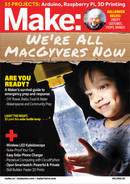
R
esponding effectively to emergencies and
disasters is almost always a result of
preparation. With a little forethought,
know-how, and advance planning, makers with a
DIY and community mindset are fantastically
positioned to help themselves and others in
extreme situations.
But which threats should we invest in
preparing for? Risk is calculated by multiplying
likelihood times consequences. Many small
emergencies have minimal consequences, but
happen frequently: power failures, network
outages, even supply chain problems that limit
our access to anything from food to fuel. On the
other end of the spectrum are events that are
less likely, but have dramatic impacts: disruptions
that extend over a large area or last a long
time, or rare catastrophic events like a tsunami,
earthquake, or superstorm.The likelihood varies
depending on your locality and situation.
It’s near-impossible to prepare for absolutely
any event, so determining the most significant
risks for you requires some research and
thought. But whatever the risks, your best
investment is usually to prepare to address your
most basic needs — food, water, shelter, and
security — under a range of scenarios.
Survival experts talk about the Rule of
Threes:Humans can survive about 3 hours in
extreme cold or heat, 3 days without water, and
3 weeks without food. These numbers provide
a fundamental framework for preparedness.
If you travel icy roads during northern winters,
then having an emergency kit in your trunk
with blankets and a candle heater are a must to
avoid hypothermia. If you live in an earthquake
zone, storing enough water for your family
can be a necessity.If you’re someplace where
food deliveries could be disrupted for a month,
rotating food stocks is good sense.
The topic of “survivalism” is burdened with
social and political issues that often distract
from practical emergency preparedness. History
shows that the best outcomes in disasters
emerge from strong communities working
together. So we see preparedness as something
that’s most effective when done in conjunction
with our neighbors.We will leave the topic of self-
defense for other forums to discuss.
Planning Your Prep
To structure your planning, it’s helpful to
consider some variables that will change how
you prepare for events. At the highest level,
these are: time, severity, motion, and inclusion.
TIME
How long is a disruption likely to last? It makes
a big difference in how to prepare. Having food
staples on hand is a great prep, but storing
enough for a couple weeks is very different than
for a year. Some skills, like rotating stocks so
that you use the oldest first, are great for all
plans, but worst-case scenarios can potentially
change your target from “lots of cans” to “whole
grain wheat stored in tubs with CO
2
to keep out
bugs.”It’s comforting to think we can be prepared
for any length of event, but doing so has a cost.
Determining what works for your family, space,
and budget is essential.
SEVERITY
How bad will it be? There’s a big difference
between a municipality issuing a boil water
notice and actually having the water pipes go
dry.(Or, as happened in Texas recently, a boil
water notice at the same time as natural gas
being cut off to residences!)Simple prep might
be having a couple gallons of water on hand
HOW MAKERS CAN PREPARE
FOR DISRUPTIONS AND
DISASTERS OF ALL KINDS
Written by Tim Deagan
Self-
actualization:
achieving one’s full
potential, including
creative activities
Self-fulfillment needs
Esteem needs:
prestige, feeling of
accomplishment
Belongingness & love needs:
intimate relationships, friends
Safety needs:
security, safety
Physiological needs:
food, water, warmth, rest
Psychological needs
Basic needs
Abraham Maslow’s classic hierarchy of human needs.
23
make.co
Adobe Stock - top vectors, Androidmarsexpress, CC BY-SA 4.0
M82_022-33_SS_Open_TimPiece_F1.indd 23M82_022-33_SS_Open_TimPiece_F1.indd 23 7/12/22 9:55 AM7/12/22 9:55 AM
..................Content has been hidden....................
You can't read the all page of ebook, please click here login for view all page.
